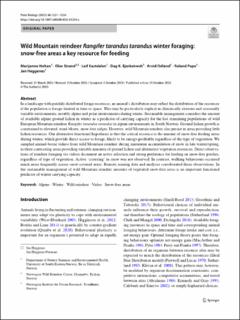| dc.contributor.author | Holtan, Marijanne | |
| dc.contributor.author | Strand, Olav | |
| dc.contributor.author | Kastdalen, Leif | |
| dc.contributor.author | Bjerketvedt, Dag Kjartan | |
| dc.contributor.author | Odland, Arvid | |
| dc.contributor.author | Pape, Roland | |
| dc.contributor.author | Heggenes, Jan | |
| dc.coverage.spatial | South Norway | en_US |
| dc.date.accessioned | 2024-02-06T14:27:32Z | |
| dc.date.available | 2024-02-06T14:27:32Z | |
| dc.date.created | 2023-11-06T12:42:10Z | |
| dc.date.issued | 2023 | |
| dc.identifier.citation | Polar Biology. 2023, 46 1321-1334. | en_US |
| dc.identifier.issn | 0722-4060 | |
| dc.identifier.uri | https://hdl.handle.net/11250/3116003 | |
| dc.description.abstract | In a landscape with patchily distributed forage resources, an animal’s distribution may reflect the distribution of the resources if the population is forage-limited in time or space. This may be particularly explicit in climatically extreme and seasonally variable environments, notably alpine and polar environments during winter. Sustainable management considers the amount of available alpine ground lichen in winter as a predictor of carrying capacity for the last remaining populations of wild European Mountain reindeer Rangifer tarandus tarandus in alpine environments in South Norway. Ground lichen growth is constrained to elevated, wind-blown, snow-free ridges. However, wild Mountain reindeer also persist in areas providing little lichen resources. Our alternative functional hypothesis is that the critical resource is the amount of snow-free feeding areas during winter, which provide direct access to forage, likely to be energy-profitable regardless of the type of vegetation. We sampled animal-borne videos from wild Mountain reindeer during maximum accumulation of snow in late winter/spring, in three contrasting areas providing variable amounts of ground lichen and alternative vegetation resources. Direct observations of reindeer foraging via videos document an active selection and strong preference for feeding on snow-free patches, regardless of type of vegetation. Active ‘cratering’ in snow was not observed. In contrast, walking behaviours occurred much more frequently across snow-covered areas. Remote sensing data and analyses corroborated these observations. In the sustainable management of wild Mountain reindeer amounts of vegetated snow-free areas is an important functional predictor of winter carrying capacity. Alpine · Winter · Wild reindeer · Video · Snow-free areas | en_US |
| dc.language.iso | eng | en_US |
| dc.rights | Navngivelse 4.0 Internasjonal | * |
| dc.rights.uri | http://creativecommons.org/licenses/by/4.0/deed.no | * |
| dc.subject | Alpine | en_US |
| dc.subject | Winter | en_US |
| dc.subject | Wild reindeer | en_US |
| dc.subject | Video | en_US |
| dc.subject | Snow-free areas | en_US |
| dc.title | Wild Mountain reindeer Rangifer tarandus tarandus winter foraging: snow-free areas a key resource for feeding | en_US |
| dc.title.alternative | Wild Mountain reindeer Rangifer tarandus tarandus winter foraging: snow-free areas a key resource for feeding | en_US |
| dc.type | Peer reviewed | en_US |
| dc.type | Journal article | en_US |
| dc.description.version | publishedVersion | en_US |
| dc.rights.holder | © 2023 The Authors | en_US |
| dc.subject.nsi | VDP::Zoologiske og botaniske fag: 480 | en_US |
| dc.subject.nsi | VDP::Zoology and botany: 480 | en_US |
| dc.source.pagenumber | 1321-1334 | en_US |
| dc.source.volume | 46 | en_US |
| dc.source.journal | Polar Biology | en_US |
| dc.identifier.doi | 10.1007/s00300-023-03204-x | |
| dc.identifier.cristin | 2192597 | |
| dc.relation.project | Andre: Norwegian Wild Reindeer Centre | en_US |
| cristin.ispublished | true | |
| cristin.fulltext | original | |
| cristin.qualitycode | 1 | |

